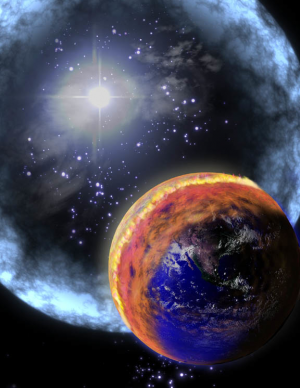December 10, 2014 report
Researchers learn more about the possible role of gamma ray bursts on life extinction in the universe

(Phys.org)—A pair of astrophysicists studying gamma ray bursts has found that such events might play a much larger role in the existence of life on Earth and other planets than has been thought. In their paper published in the journal Physical Review Letters, Tsvi Piran with the Hebrew University in Israel and Raul Jimenez from the University of Barcelona in Spain, suggest that gamma ray bursts might be responsible for past extinctions on Earth, and for limiting the possibility of life on planets near the center of galaxies.
A gamma ray burst (GRB) is a massive wave of radiation that comes about very quickly due either from a star that is dying or when two neutron stars collide. When the wave strikes another planet it can cause major disruptions.
GRBs come in two varieties, long and short burst. The longer variety are much more common but until recently scientists didn't believe they could occur in our part of the universe at all because it was thought they only occurred in low low-metallicity galaxies. More recently it has been found that though more rare, they do also occur in high-metallicity galaxies like ours. Such findings led the researchers with this new effort to wonder what impact GRBs might have had, or continue to have, on the existence of life on planets, including ours.
Among other things, they found that based on the likely average incidence of GRBs happening close enough, calculations showed a 60 percent likelihood that a GRB has caused an extinction event here on Earth within just the past billion years. They also found that planets are likely to be less impacted by GRBs the farther away from the center of their galaxy they are simply because there are less such events occurring due to the existence of fewer stars in general. They also noted that it appears unlikely any form of life would have been able to survive anywhere in the known universe prior to 5 billion years ago, as galaxies were so compact before then and strikes would have been very common.
The researchers don't believe a GRB striking the Earth could penetrate the atmosphere, but do believe one could destroy the ozone layer, which would of course lead to the extinction of most living things. They believe it's possible that such a strike could be the cause behind the Ordovician extinction, approximately 440 million years ago.
More information: Possible Role of Gamma Ray Bursts on Life Extinction in the Universe, Phys. Rev. Lett. 113, 231102 – Published 5 December 2014. dx.doi.org/10.1103/PhysRevLett.113.231102 . Arxiv: arxiv.org/abs/1409.2506
ABSTRACT
As a copious source of gamma rays, a nearby galactic gamma ray burst (GRB) can be a threat to life. Using recent determinations of the rate of GRBs, their luminosity function, and properties of their host galaxies, we estimate the probability that a life-threatening (lethal) GRB would take place. Amongst the different kinds of GRBs, long ones are most dangerous. There is a very good chance (but no certainty) that at least one lethal GRB took place during the past 5 gigayears close enough to Earth as to significantly damage life. There is a 50% chance that such a lethal GRB took place during the last 500×106 years, causing one of the major mass extinction events. Assuming that a similar level of radiation would be lethal to life on other exoplanets hosting life, we explore the potential effects of GRBs to life elsewhere in the Galaxy and the Universe. We find that the probability of a lethal GRB is much larger in the inner Milky Way (95% within a radius of 4 kpc from the galactic center), making it inhospitable to life. Only at the outskirts of the Milky Way, at more than 10 kpc from the galactic center, does this probability drop below 50%. When considering the Universe as a whole, the safest environments for life (similar to the one on Earth) are the lowest density regions in the outskirts of large galaxies, and life can exist in only ≈10% of galaxies. Remarkably, a cosmological constant is essential for such systems to exist. Furthermore, because of both the higher GRB rate and galaxies being smaller, life as it exists on Earth could not take place at z>0.5. Early life forms must have been much more resilient to radiation.
Journal information: Physical Review Letters , arXiv
© 2014 Phys.org



















